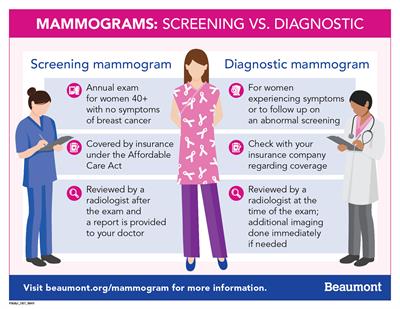
Getting regular mammograms is widely acknowledged to be the best way to detect breast cancer early, when women have the most treatment options and the chances of a favorable prognosis are the highest.
But not all mammograms are the same. There are two different primary types - screening mammograms and diagnostic mammograms - and some important differences between the two.
Screening mammograms are performed for women who have no symptoms or signs of breast cancer and are considered at average risk for breast cancer. Your first mammogram is considered a baseline mammogram against which all future tests will be compared to look for changes in your breast tissue.
Dr. Lisa Awan, a diagnostic radiologist with Beaumont, said women should start getting mammograms annually starting at age 40, or 10 years prior to the age when a first-degree relative - meaning your mother or a sister - received a breast cancer diagnosis.
Beaumont stands with the recommendations of organizations such as the National Comprehensive Cancer Network and American College of Surgeons that women get a screening mammogram each year starting at age 40. They’re also recommended for women age 30 or older who have a known genetic syndrome and are at higher risk for getting breast cancer.
“Screening mammograms are still our best tools to save lives,” Dr. Awan said.
 Diagnostic mammograms are used for women who have symptoms such as a lump, pain, nipple thickening or discharge, or whose breasts have changed shape or size. Providers also use these to evaluate abnormalities detected in a screening mammogram.
Diagnostic mammograms are used for women who have symptoms such as a lump, pain, nipple thickening or discharge, or whose breasts have changed shape or size. Providers also use these to evaluate abnormalities detected in a screening mammogram.
“Often this is followed by a targeted breast ultrasound to further evaluate the area,” Dr. Awan said. “Once a decision is made, the patient might either return back to screening, come back for a follow-up study or have a biopsy.”
Both types of mammograms use low-dose X-rays to examine the breast. They may use either the standard 2-dimensional digital mammography or 3-D mammograms known as tomosynthesis. Beaumont’s 17 regional Breast Imaging Centers offer access to those and other technologies, including ABUS whole-breast ultrasound, breast MRI and more.
Other key differences
While the technology is basically the same, there are a few key differences between screening and diagnostic mammograms that you should know:
- Screening mammograms usually take around 10 to 15 minutes, while diagnostic screenings may take longer, since the technician may take more X-ray images and may zoom in on areas of interest.
- Your supervising physician doesn’t need to be present for a screening mammogram, whereas the interpreting physician is present monitoring the diagnostic version.
- Since 2010, the Affordable Care Act has required all new health insurance plans to cover screening mammograms in full, with no out-of-pocket charges for patients. Medicare also pays for mammography screening for women 40 and older. Diagnostic mammograms aren’t subject to that requirement, however, and are subject to the terms of private insurance plans.
“Most private insurance companies and employer-based insurances pay for screening mammograms with no cost sharing,” said Roseanna Von Linsowe, a patient access and registration supervisor with Beaumont. “Low income women who are uninsured or underinsured can apply for a free mammogram through the Michigan Breast and Cervical Cancer Control Program."
Next Steps and Helpful Resources
- Why Beaumont recommends annual screenings starting at age 40.
- Watch our video on what to expect from your first mammogram.
- Download our free guide and learn everything you need to know about breast health.
